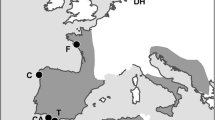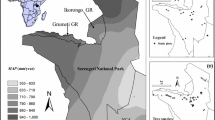Abstract
Myricaria laxiflora is an endangered plant that grows in the flood zone along the Yangtze River in the Three Gorges area from 70 m to 155 m above sea level. To understand the spatial distribution patterns of the species and to provide information for developing conservation strategies, we used field surveys to study its seed reproduction and dispersion, and used growth chambers to study seed germination. Results showed that M. laxiflora produced many flowering branches, inflorescences and seeds. Seeds were very small and output was high although biomass allocation to reproduction was low (∼4%). Reproductive allocation was strongly correlated with the biomass of stems and leaves. Seeds were dispersed either by the wind or the river current. Wind-dispersed seeds usually settled within 25 m from parent plants leading to a clumped distribution of individuals in populations. Water-dispersed seeds often landed and established on strands of firth where the fine sediment and gentle sloping were available. Seedlings that emerged from water-dispersed seeds were distributed along the water flood line.
The life-span of M. laxiflora seeds was about 7 days. Seeds could germinate within 24 h when they absorbed adequate amounts of water. Soil water content was a key factor limiting the establishment ability of M. laxiflora. Experiments showed that the minimum soil water content for germination to occur was 10% on sand or 17% on sandy soil substrates, and the optimal conditions were on saturated soils. The water content of sandy soils on the riverbank was lower than 10% in autumn, the dry season, and seeds were able to germinate only on sandy beaches that were intermittently inundated by the fluctuating river current. These characteristics of seed dispersal and germination limit the ability for M. laxiflora to expand its distribution. These results provide information essential for the conservation and reintroduction of this endangered species.






Similar content being viewed by others
References
Boeken B, Ariza C, Gutterman Y, Zaady E (2004) Environmental factors affecting dispersal, germination and distribution of Stipa capensis in the Negev Desert, Israel. Ecol Res 19:533–540
Changjiang Water Resource Commission (1997) The effects of Three Gorges Project on ecological environment. Wuhan, Hubei Science and Technology Press (in Chinese)
Chen F-Q, Xie Z-Q, Xiong G-M, Liu Y-M, Yang H-Y (2005a) Reintroduction and population reconstruction of an endangered plant Myricaria laxiflora in the Three Gorges Reservoir area, China. Acta Ecol Sin 25:1811–1817 (in Chinese)
Chen F-Q, Xie Z-Q, Xiong G-M (2005b) Effects of density on seedling survival and growth of an endangered species Myricaria laxiflora. Biodivers Sci 13:332–338 (in Chinese)
Clark JS (1998) Why trees migrate so fast: confronting theory with dispersal biology and the paleorecord. Am Nat 152:204–224
Cook CDK (1987) Dispersion in aquatic and amphibious vascular plants. In: Crawford RMM (ed) Plant life in aquatic and amphibious habitats. Blackerwell, Oxford, UK, pp 179–190
Fiedler PL, Ahouse JJ (1992) Hierarchies of cause toward an understanding of rarity in vascular plant species. In: Fiedler PL, Jain SD (eds) Conservation biology: the theory and practice of nature conservation, preservation, and management. Chapman & Hall, Inc., New York, Routledge, pp 23–48
Ford RH, Sharik TL, Feret PP (1983) Seed dispersal of the endangered Virginia round-leaf birch (Betula uber). Forest Ecol Manage 6:115–128
Guariguata MR, Pinardc MA (1998) Ecological knowledge of regeneration from seed in neotropical forest trees: implications for natural forest management. Forest Ecol Manage 112:87–99
Harper JL (1977) Population biology of plants. Academic Press, London
He T, Krauss SL, Lamont BB, Miller BP, Enright NJ (2004) Long-distance seed dispersal in a metapopulation of Banksia hookeriana inferred from a population allocation analysis of amplified fragment length polymorphism data. Mol Ecol 13:1099–1110
Horn HS, Nathan RAN, Kaplan SR (2001) Long-distance dispersal of tree seeds by wind. Ecol Res 16:877–885
Houle G (1982) Seed dispersal and seedling recruitment of Betula alleghaniensis, spatial inconsistency in time. Ecology 79:807–818
Howe HF, Smallwood J (1982) Ecology of seed dispersal. Annu Rev Ecol Syst 13:201–228
Jakobsson A, Eriksson O (2000) A comparative study of seed number, seed size, seedling size and recruitment in grassland plants. Oikos 88:494–502
Joseph WS, Helene MC, Osvaldo C, Andrés H (2005) Annual and spatial variation in seedfall and seedling recruitment in Neotropical forest. Ecology 86:848–861
Kelly CK, Purvis A (1993) Seed size and establishment conditions in tropical trees, on the use of taxonomic relatedness in determining ecological patterns. Oecologia 94:356–360
Kunstler G, Curt T, Lepart J (2004) Spatial pattern of beech (Fagus sylvatica L.) and oak (Quercus pubescens Mill.) seedlings in natural pine (Pinus sylvestris L.) woodlands. Eur J Forest Res 123:331–337
Li Z-Z, Wang C-H, Xu T-Q, Wu J-Q, Huang H-W (2003) Conservation genetics of the endemic species Myricaria laxiflora (Tamaricaceae) in the Three Gorges Reservoir area, Hubei. Biodivers Sci 11:109–117 (in Chinese)
Liu Y-F, Wang Y, Huang H-W (2006) High interpopulation genetic differentiation and unidirectional linear migration patterns in Myricaria laxiflora (Tamaricaceae), an endemic riparian plant in the Three Gorges valley of the Yangtze River. Am J Bot 93:206–215
Lookingbill TR, Zavala MA (2000) Spatial pattern of Quercus ilex and Quercus pubescens recruitment in Pinus halepensis dominated woodlands. J Veg Sci 11:607–612
Manfred J, Lesley P, Birgitte S (2004) Habitat specificity, seed germination and experimental translocation of the endangered herb Brachycome muelleri (Asteraceae). Biol Conserv 116:251–267
Middleton BA (1999) Wetland restoration: flood pulsing and disturbance dynamics. Wiley, New York, NY, USA
Mills MH, Schwartz MW (2005) Rare plants at the extremes of distribution: broadly and narrowly distributed rare species. Biodivers Conserv 14:1401–1420
Oliver T, Peter P, Susanne B (2003) Assessment of wind dispersal potential in plant species. Ecol Monogr 73:191–206
Ouborg NJ, Piquot Y, van Groenendael JM (1999) Population genetics, molecular markers, and the study of dispersal in plants. J Ecol 87:551–569
Parolin P (2001) Seed germination and early establishment of 12 tree species from nutrient-rich and nutrient-poor Central Amazonian floodplains. Aquat Bot 70:89–103
Parolin P, De Simone O, Haase K, Junk WJ, Waldhoff D, Rottenberger S, Kuhn U, Kesselmeier J, Kleiss B, Schmidt W, Piedade MTF (2004) Central Amazonian floodplain forests: tree adaptations in a pulsing System. Bot Rev 70:357–381
Pickering CM, Arthur JM (2003) Patterns of resource allocation in the dioecious alpine herb Aciphylla simplicifolia (Apiaceae). Austr Ecol 28:566–574
Schupp EW, Fuentes M (1995) Spatial patterns of seed dispersal and the unification of plant population ecology. Ecoscience 2:267–275
Soons MLB, Heil GW, Nathan R, Katul GG (2004) Determinants of long-distance seed dispersal by wind in grasslands. Ecology 85:3056–3067
Tilman D, Kareiva P (1997) Spatial ecology: the role of space in population dynamics and interspecific interactions. Princeton University Press, Princeton
Wall SBV, Longland WS (2004) Diplochory: are two seed dispersers better than one? Trends Ecol Evol 19:155–161
Wang Y, Wu J-Q, Tao Y, Li Z-Z, Huang H-W (2003) Natural distribution and ex situ conservation of endemic species Myricaria laxiflora water-level-fluctuation zone within Three-Gorges reservoir area of Changjiang River. J Wuhan Bot Res 21:415–422 (in Chinese)
Willson MF (1993) Dispersal mode, seed shadows, and colonization patterns. Vegetation 106/107:261–280
Wu J-Q, Zao Z-E, Jin Y-X, Shen Z-H (1998) Investigation and study on the endemic plant Myricaria laxiflora in the Three Gorges reservoir area. J Wuhan Bot Res 16:111–116 (in Chinese)
Zhang D-Y, Jiang X-H (2002) Size-dependent resource allocation and sex allocation in herbaceous perennial plants. J Evol Biol 15:74–83
Zhao R-L, Du G-Z, Ren Q-J (2004) Size-dependent reproduction and sex allocation in five species of Ranunculaceae. Acta Phytoecol Sin 28:9–16 (in Chinese)
Acknowledgements
We would like to thank Dr. Ke-Ping Ma, Dr. Ruth E. Sherman and Dr. Zheng-Qing Li for their helpful comments on this manuscript. The Three Gorge Project Construction Committee of the State Council provided fund for this research. Two anonymous referees gave us very interesting comments to the final improvement of this work.
Author information
Authors and Affiliations
Corresponding author
Rights and permissions
About this article
Cite this article
Chen, FQ., Xie, ZQ. Reproductive allocation, seed dispersal and germination of Myricaria laxiflora, an endangered species in the Three Gorges Reservoir area. Plant Ecol 191, 67–75 (2007). https://doi.org/10.1007/s11258-006-9214-4
Received:
Accepted:
Published:
Issue Date:
DOI: https://doi.org/10.1007/s11258-006-9214-4




